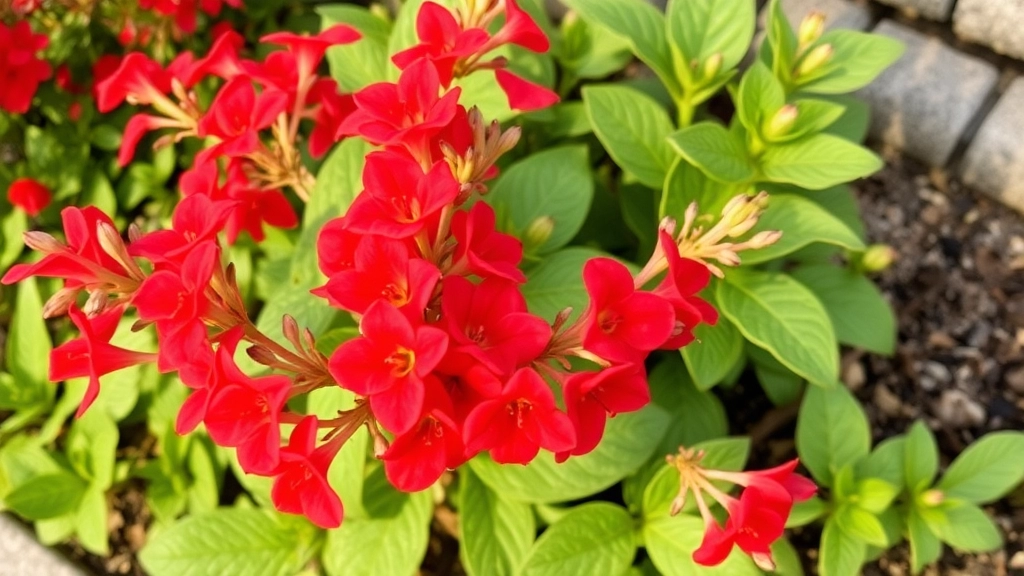Kalanchoe Red Flowers
Are you looking to add a splash of vibrant red to your garden or home? Kalanchoe Red Flowers might be just what you need. These stunning succulents are not only easy to care for but also bring a pop of colour that can brighten any space. Whether you’re a seasoned gardener or just starting out, understanding the best growing conditions for Kalanchoe Red Flowers is key to enjoying their beautiful blooms.
Growing Conditions
To get the most out of your Kalanchoe Red Flowers, you’ll need to know about their light requirements, watering needs, and optimal temperature conditions. These plants thrive in bright, indirect light and prefer well-draining soil to prevent root rot. With the right care, your Kalanchoe can flourish both indoors and outdoors, providing you with vibrant red flowers year-round.
Best Growing Conditions for Kalanchoe Red Flowers
Are you struggling to get your Kalanchoe red flowers to thrive? You’re not alone. Many plant enthusiasts face challenges in creating the ideal environment for these stunning succulents. Understanding the best growing conditions is essential for vibrant blooms and overall plant health.
Ideal Environment
Kalanchoe plants flourish in specific conditions that mimic their native habitats. Here’s what you need to focus on:
- Bright Indirect Light: Kalanchoe thrives in bright, indirect sunlight. Too much direct sun can scorch the leaves, while too little can hinder blooming.
- Well-Draining Soil: A well-draining potting mix is crucial. A cactus or succulent blend works wonders. This prevents root rot, a common issue with Kalanchoe. For more tips, check out our guide on growing and caring for Kalanchoe Luciae.
- Moderate Humidity: These plants prefer a drier environment. High humidity can lead to fungal issues, so aim for a humidity level around 40-50%.
- Temperature Control: Kalanchoe red flowers prefer temperatures between 18-24°C (65-75°F). Avoid exposing them to extreme cold or heat. For more detailed care instructions, visit our expert tips for thriving Kalanchoe plants.
Light Requirements for Kalanchoe Plants
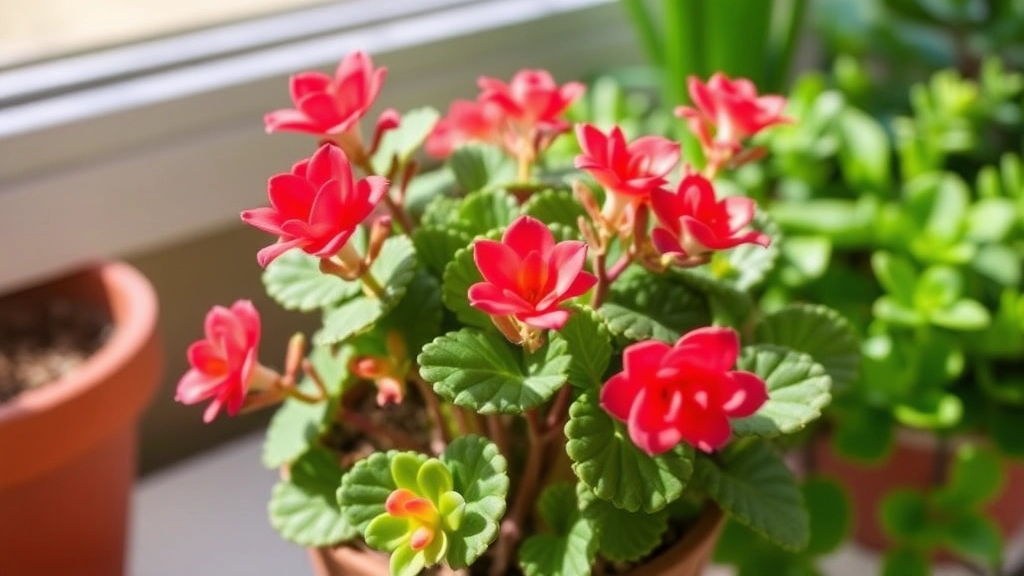
So, you’ve got your eye on those stunning Kalanchoe red flowers, but are you giving them the right light?
Getting the light just right is crucial for these beauties to thrive.
What Do Kalanchoe Need?
- Bright, Indirect Light: Kalanchoe plants love bright light but don’t go shoving them in direct sunlight all day. This can scorch their leaves.
- 6 Hours of Light: Aim for about six hours of bright, indirect sunlight daily. A south-facing window is usually a winner.
- Signs of Too Much Light: If you see yellowing leaves or wilting, it might be a sign they’re getting too much sun.
- Signs of Too Little Light: On the flip side, if the leaves are stretching out or the plant looks leggy, it’s craving more light.
Seasonal Changes
- Winter Care: During the colder months, they might need a bit more light since days are shorter.
- Adjusting Position: Feel free to move them around. If you notice any changes, don’t hesitate to find a better spot.
Indoor vs. Outdoor Light
- Indoor: If you’re keeping them inside, consider using grow lights if your home doesn’t get enough natural light.
- Outdoor: If you’re growing them outside, find a spot that gets morning sun but is shaded in the afternoon.
Quick Tips
- Rotate your plant every couple of weeks for even light exposure.
- Watch for signs and adjust accordingly.
How to Water Kalanchoe Succulents
When it comes to watering Kalanchoe succulents, many plant enthusiasts often wonder if they’re giving their plants too much or too little moisture. This delicate balance is crucial for the health of your vibrant red flowers.
Understanding Watering Needs
Kalanchoe plants are succulents, which means they store water in their leaves. This adaptation allows them to thrive in arid conditions. Here are some key points to consider:
- Soil Moisture Check: Always check the top inch of soil. If it feels dry, it’s time to water.
- Watering Frequency: Generally, watering every two to three weeks is sufficient. However, this can vary based on temperature and humidity.
- Watering Technique: Water thoroughly until it drains from the bottom of the pot. This ensures the roots receive adequate moisture without becoming waterlogged.
Signs of Overwatering and Underwatering
Understanding the signs of improper watering can save your Kalanchoe from distress:
Temperature Tolerances for Red Kalanchoe
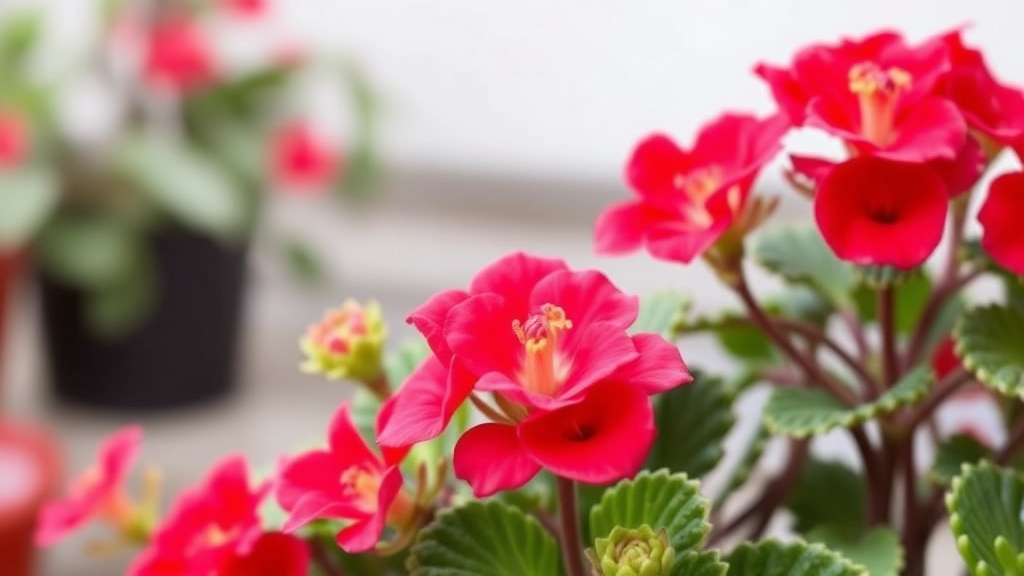
When it comes to caring for your Kalanchoe with red flowers, understanding temperature tolerances is essential. You might be wondering, “What temperatures can my Kalanchoe handle?” or “Will my plant thrive in my home environment?”
Kalanchoe plants are quite adaptable, but they do have their preferred temperature ranges:
- Ideal Temperature Range: 20°C to 25°C (68°F to 77°F) during the day.
- Nighttime Temperatures: They can tolerate cooler nights, ideally around 15°C to 18°C (59°F to 64°F).
- Cold Sensitivity: Avoid exposing them to temperatures below 10°C (50°F), as this can cause stress and affect blooming.
- Heat Tolerance: While they can handle warmer conditions, prolonged temperatures above 30°C (86°F) may lead to wilting.
Understanding these tolerances can help ensure your red Kalanchoe remains vibrant and healthy.
If you notice your plant wilting or dropping leaves, it might be a sign of temperature stress.
To keep your Kalanchoe thriving, consider these tips:
- Placement: Position your plant away from drafts, heating vents, or air conditioning units.
- Monitoring: Use a thermometer to keep an eye on indoor temperatures, especially during seasonal changes.
By creating a stable environment, you can encourage your Kalanchoe to flourish.
Propagating Kalanchoe red flowers can be both rewarding and straightforward.
There are a couple of effective methods to propagate Kalanchoe, and both are suitable for beginners. Here’s a quick breakdown:
– **Leaf Cuttings:**
– Choose a healthy leaf from the parent plant.
– Cut it cleanly at the base.
– Allow the cut end to dry for a few days until a callus forms.
– Place the leaf on well-draining soil and mist lightly.
– **Stem Cuttings:**
– Select a healthy stem with at least two leaves.
– Cut just below a leaf node.
– Let the cut end dry for a few days.
– Plant it in soil, ensuring the leaf nodes are buried slightly.
For more detailed guidance on propagating Kalanchoe, you might find this [complete guide to Kalanchoe Mother of Thousands care and propagation](https://planthq.org/complete-guide-to-kalanchoe-mother-of-thousands-care-propagation/) helpful. Additionally, if you’re interested in learning about the different varieties and care tips for Kalanchoe, check out this [guide on Kalanchoe Tomentosa varieties, care, types, and propagation](https://planthq.org/kalanchoe-tomentosa-varieties-care-types-and-propagation/).
**Tips for Successful Propagation:**
– **Timing:** The best time to propagate is during the growing season, typically in spring or early summer.
– **Light:** Place cuttings in a bright location but avoid direct sunlight to prevent scorching.
– **Watering:** Water sparingly until roots develop. Overwatering can lead to rot.
– **Patience:** It may take a few weeks for roots to establish, so be patient.
Soil and Potting Recommendations for Kalanchoe Red Flowers
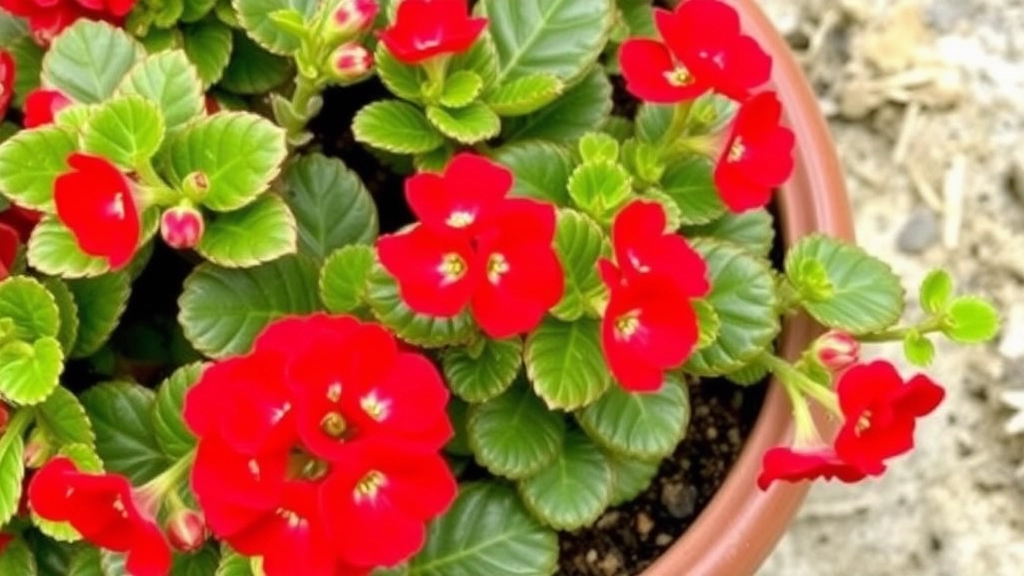
So, you’ve got your Kalanchoe red flowers all set, but have you thought about what they’re sitting in?
The right soil and potting conditions can make all the difference in keeping your plant happy and blooming beautifully.
Choosing the Right Soil
Kalanchoe plants thrive in soil that drains well. Here’s what to look for:
- Cactus or Succulent Mix: This is ideal as it allows excess water to escape quickly.
- Add Perlite or Sand: Mixing in some perlite or coarse sand can enhance drainage even more.
- pH Level: Aim for a slightly acidic to neutral pH (around 6.0 to 7.0).
Potting Tips
Now, let’s talk pots. The right pot can help your Kalanchoe flourish:
- Drainage Holes: Always choose pots with drainage holes to prevent waterlogging.
- Size Matters: Pick a pot that’s just a bit larger than the root ball. Too big can hold too much moisture.
- Material: Terracotta pots are great as they’re porous and help with moisture control.
Repotting
You might need to repot your Kalanchoe every couple of years. Here’s when and how:
- When to Repot: If you notice roots coming out of the drainage holes or the plant looks top-heavy.
- How to Repot: Gently remove the plant, shake off excess soil, and place it in fresh soil mix.
By keeping these soil and potting tips in mind, your Kalanchoe red flowers will have the perfect home to thrive.
Fertilizing Tips for Maximizing Blooms
Having discussed the essential growing conditions for Kalanchoe, let’s dive into the crucial aspect of fertilization to ensure those vibrant red blooms flourish.
Understanding Fertilization Needs
Kalanchoe plants, particularly the red-flowered varieties, thrive with the right nutrients. Proper fertilization can significantly enhance blooming and overall plant health. Here are some key tips to consider:
- Choose the Right Fertilizer: Opt for a balanced, water-soluble fertilizer with a ratio of 10-10-10 or a bloom-boosting formula like 15-30-15. This ensures your Kalanchoe receives the necessary nutrients for blooming.
- Frequency of Application: Fertilize your Kalanchoe every 4-6 weeks during the growing season (spring and summer). Reduce or stop fertilizing in the fall and winter when the plant is dormant.
- Dilution is Key: Always dilute the fertilizer to half the recommended strength. This prevents over-fertilization, which can harm the plant.
- Watering After Fertilization: Water your Kalanchoe thoroughly after applying fertilizer. This helps distribute the nutrients evenly and prevents root burn.
- Signs of Nutrient Deficiency: Watch for yellowing leaves or stunted growth, which may indicate a lack of nutrients. Adjust your fertilization routine accordingly.
Organic Options
If you prefer a more natural approach, consider using compost or a diluted liquid seaweed solution. These organic options provide slow-release nutrients and improve soil health. For additional tips on keeping your Kalanchoe healthy, check out our complete guide to caring for Kalanchoe succulents.
For those interested in specific varieties, our ultimate guide to growing Kalanchoe pink flowers offers detailed care instructions to ensure your plants thrive.
Common Issues and Troubleshooting

So, you’ve got your Kalanchoe red flowers thriving, but then you start noticing some hiccups. What’s going wrong?
Common Problems
Here are some typical issues you might face:
- Overwatering: This is the number one killer for Kalanchoe. If the leaves start turning yellow or mushy, you might be giving it too much water.
- Underwatering: On the flip side, if the leaves look shriveled and dry, it’s crying out for a drink.
- Pest Infestations: Keep an eye out for mealybugs or aphids. They can sneak in and cause havoc.
- Leaf Drop: If your Kalanchoe is shedding leaves, it could be a sign of stress from temperature changes or improper watering.
Solutions
- For Overwatering: Let the soil dry out completely before watering again. If it’s really soggy, consider repotting in fresh soil.
- For Underwatering: Give it a good soak, but make sure excess water can drain away.
- For Pests: A gentle spray of insecticidal soap can help. Just ensure you get under the leaves where they tend to hide.
- For Leaf Drop: Check the environmental conditions. Is it too hot or too cold? Adjust accordingly.
Prevention Tips
- Water Wisely: Always check the soil before watering. Stick your finger in about an inch deep; if it’s dry, it’s time to water.
- Monitor Light: Ensure your Kalanchoe is getting the right amount of light. If it’s too dim, it can weaken the plant.
- Regular Checks: Make it a habit to inspect your plant weekly. Early detection of issues can save your blooms.
Indoor vs. Outdoor Kalanchoe Growing
When deciding between indoor and outdoor growing for your Kalanchoe with red flowers, it’s essential to weigh the advantages and challenges of each environment.
Indoor Growing
Benefits:
- Controlled Environment: You can regulate light, temperature, and humidity.
- Pest Management: Fewer pests and diseases compared to outdoor settings.
- Accessibility: Easy to monitor and care for your plants daily.
Challenges:
- Limited Space: May require creative arrangements for optimal light.
- Artificial Light Needs: If natural light is insufficient, you might need grow lights.
Outdoor Growing
Benefits:
- Natural Light: Ample sunlight promotes robust growth and vibrant blooms.
- Space for Expansion: More room to grow multiple plants or varieties.
Challenges:
- Weather Vulnerability: Extreme temperatures and weather can harm your Kalanchoe.
- Pest Exposure: Increased risk of pests and diseases.
Key Considerations
- Light Needs: Kalanchoe thrives in bright, indirect sunlight. Ensure your indoor setup mimics this.
- Temperature: Both indoor and outdoor settings should maintain a comfortable range of 15-25°C (59-77°F).
- Watering: Outdoor plants may require more frequent watering due to evaporation.
For more detailed tips on growing Kalanchoe indoors, check out our guide to caring for Kalanchoe house plants. If you’re interested in exploring different varieties, our top Kalanchoe succulents with red flowers article might be useful.
Pruning Techniques to Encourage New Blooms in Kalanchoe Red Flowers
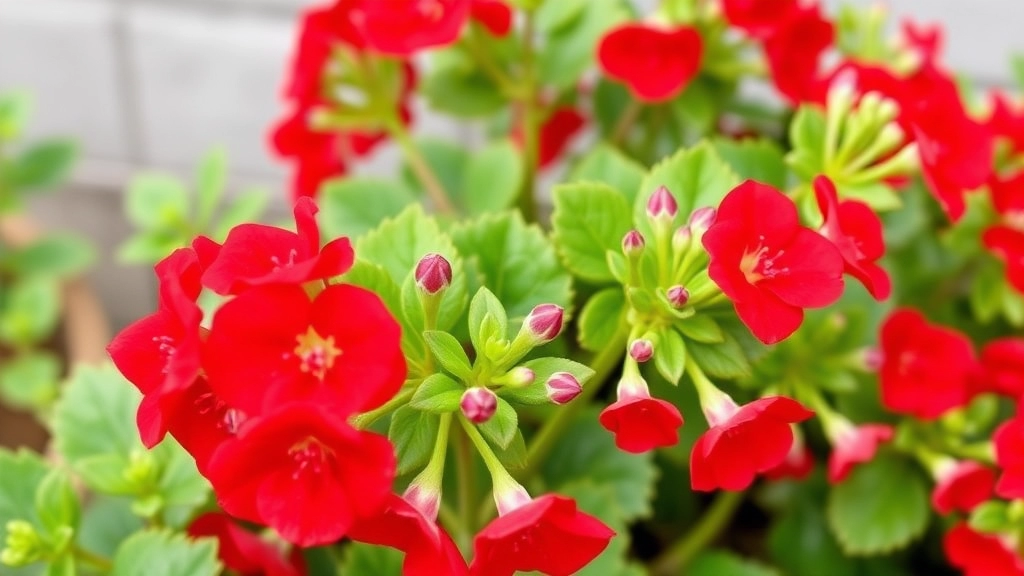
Have you ever wondered why your beautiful Kalanchoe isn’t blooming as much as you’d like?
Pruning is one of the best ways to encourage those vibrant red flowers to flourish.
When to Prune
- Post-Bloom: Wait until your Kalanchoe has finished flowering. This way, you won’t accidentally cut off any buds.
- Spring: The best time to prune is in early spring when the plant is waking up from dormancy.
How to Prune
- Use Clean Tools: Always use sharp, clean scissors or pruning shears to avoid disease.
- Cut Back Stems: Trim back about a third of the stems. This helps promote new growth and encourages more blooms.
- Remove Dead Leaves: Snip off any dead or yellowing leaves. This keeps your plant healthy and looking its best.
Tips for Effective Pruning
- Focus on the Shape: Aim for a balanced shape. This helps the plant distribute energy evenly.
- Don’t Overdo It: Less is more! Over-pruning can stress your Kalanchoe and stunt growth.
- Observe Growth Patterns: Pay attention to how your plant reacts. Adjust your pruning techniques based on its response.
Popular Varieties of Red-Flowered Kalanchoe
As we delve into the vibrant world of Kalanchoe, it’s essential to highlight some popular varieties that showcase stunning red flowers. These selections not only bring colour to your space but also offer unique characteristics that cater to different gardening preferences.
Kalanchoe blossfeldiana
This is perhaps the most well-known variety.
- Flowering: Produces clusters of small, bright red flowers.
- Height: Typically grows up to 30 cm.
- Care: Requires moderate sunlight and careful watering to thrive.
Kalanchoe ‘Calandiva’
A hybrid that’s gaining popularity for its double blooms.
- Flowering: Features lush, ruffled red flowers.
- Height: Can reach around 30-45 cm.
- Care: Prefers bright, indirect light and well-draining soil.
Kalanchoe thyrsiflora
Commonly known as the flapjack plant, this variety has a unique leaf structure.
- Flowering: Produces bright red flower spikes.
- Height: Can grow up to 60 cm.
- Care: Thrives in full sun and requires minimal watering.
Kalanchoe luciae
Also known as the paddle plant, it offers a striking visual appeal.
- Flowering: Displays vibrant red flowers on tall stalks.
- Height: Grows around 30-45 cm.
- Care: Needs plenty of sunlight and well-draining soil to flourish.
These varieties not only enhance your garden but also serve as excellent indoor plants. Each type has its own charm and care requirements, making them suitable for both novice and experienced gardeners. For more detailed care guides, you can explore our articles on Kalanchoe blossfeldiana care and Kalanchoe luciae care.
FAQs on Kalanchoe Red Flowers
What type of light is best for Kalanchoe red flowers?
Kalanchoe plants thrive in bright, indirect light. They need about six hours of light daily. Direct sunlight can scorch their leaves, so it’s best to place them near a south-facing window or use grow lights if necessary.
How do I know if my Kalanchoe is getting too much or too little light?
If the leaves are yellowing or wilting, your plant might be getting too much sunlight. Conversely, if the leaves are stretching out or the plant looks leggy, it needs more light.
What temperatures are ideal for Kalanchoe red flowers?
The ideal temperature range is between 20°C to 25°C (68°F to 77°F) during the day and around 15°C to 18°C (59°F to 64°F) at night. Avoid exposing them to temperatures below 10°C (50°F) or above 30°C (86°F).
What type of soil is best for Kalanchoe?
Kalanchoe plants prefer soil that drains well. A cactus or succulent mix is ideal. Adding perlite or coarse sand can further enhance drainage. Aim for a slightly acidic to neutral pH (around 6.0 to 7.0).
How often should I repot my Kalanchoe?
You should consider repotting your Kalanchoe every couple of years or when you notice roots coming out of the drainage holes or the plant looks top-heavy.
What are common issues with Kalanchoe red flowers and how can I solve them?
Common issues include overwatering, underwatering, pest infestations, and leaf drop. Solutions involve adjusting your watering habits, using insecticidal soap for pests, and checking environmental conditions like temperature and light.
When and how should I prune my Kalanchoe to encourage new blooms?
Prune your Kalanchoe post-bloom or in early spring. Use clean, sharp tools to cut back about a third of the stems and remove any dead or yellowing leaves. Focus on maintaining a balanced shape and avoid over-pruning to prevent stress.
Can I grow Kalanchoe red flowers both indoors and outdoors?
Yes, you can grow Kalanchoe both indoors and outdoors. For indoor growth, ensure they get enough light, possibly with grow lights. For outdoor growth, place them in a spot with morning sun and afternoon shade.
How can I prevent overwatering my Kalanchoe?
Always check the soil before watering. Stick your finger about an inch deep into the soil; if it’s dry, it’s time to water. Ensure your pot has drainage holes to prevent waterlogging.
What should I do if my Kalanchoe is wilting or dropping leaves?
Wilting or leaf drop can be signs of temperature stress or improper watering. Adjust the plant’s environment by ensuring stable temperatures and proper watering habits. Monitor the plant closely and make necessary changes.
References
-
Gardening Know How: Kalanchoe Light Requirements
-
The Spruce: How to Grow Kalanchoe Succulents
-
The Old Farmer’s Almanac: Kalanchoe
